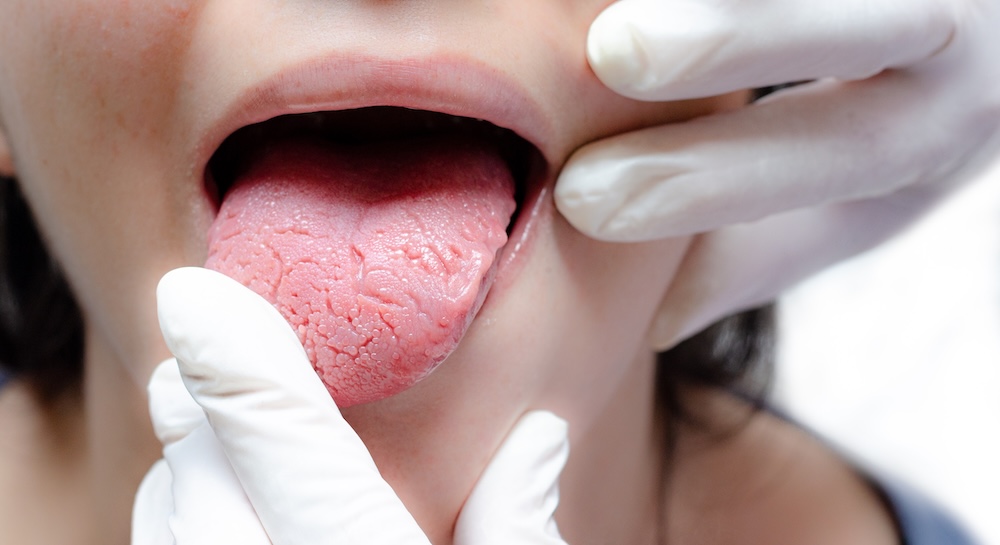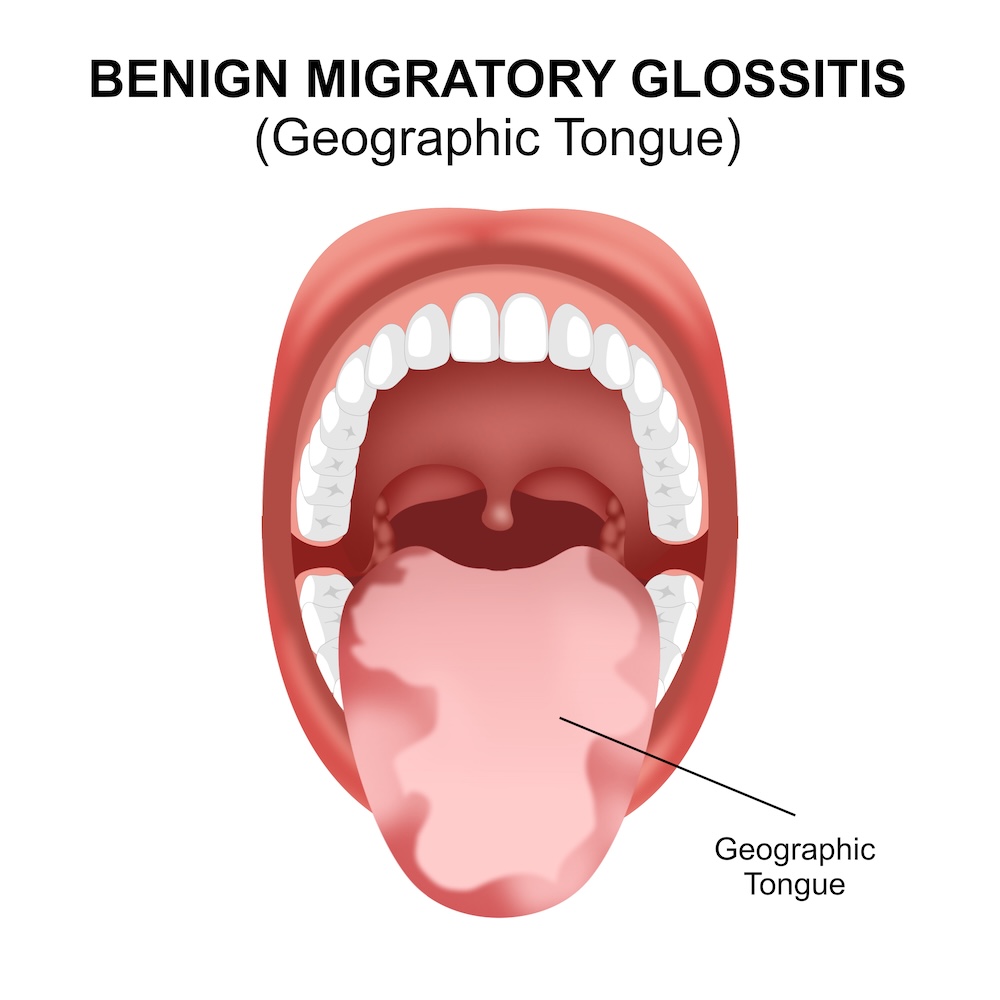Geographic Tongue: Causes, Symptoms, and Treatments

Summary
Key Takeaways
- Geographic tongue is a harmless condition and is not related to cancer or infection
- Symptoms vary and may include red patches and a burning sensation, particularly when consuming certain foods
- No known cure, but geographic tongue often resolves on its own without treatment
- Management strategies to alleviate symptoms include avoiding irritants and managing stress
- If symptoms are bothering you, see your dentist or doctor for advice
Table of Contents

This blog has been reviewed and approved by Dr Robert Lee, a dental professional of 35 years
LEARN MORE >Key Takeaways
What Is Geographic Tongue?

Geographic tongue is a benign, non-cancerous condition where the surface of the tongue develops smooth, red, irregular patches that may have slightly raised borders. These patches are areas where the tiny, finger-like bumps on the tongue, known as papillae, are missing, which gives the surface a smooth appearance. They can change in size, shape, and location over time, sometimes disappearing and reappearing elsewhere on the tongue. It's estimated to affect about 1% to 3% of the population, with a slightly higher prevalence in women.
Causes and Risk Factors
The exact cause remains unknown. However, several factors may contribute to geographic tongue:
- Genetics: Family history of geographic tongue may increase the likelihood of developing the condition
- Psoriasis: There is an association between geographic tongue and psoriasis, a skin condition characterized by itchy, scaly patches
- Allergies: Individuals with allergies may be more prone to geographic tongue, including asthma and hay fever
- Hormonal Changes: Hormonal fluctuations may influence the condition during pregnancy or if using oral contraceptives
- Nutritional Deficiencies: A lack of certain nutrients has been associated with geographic tongue including Iron, Zinc, Folic acid, and Vitamins B6 and B12
- Stress: High levels of stress can exacerbate or trigger episodes of geographic tongue
- Smoking: Interestingly, the incidence of geographic tongue appears to be lower in smokers. However, this does not suggest smoking is beneficial, as it is a major risk factor for numerous other oral and systemic diseases.
Symptoms
While many individuals with geographic tongue experience no symptoms at all, others may notice the following:
- Red, Smooth Patches: Irregularly shaped red areas on the top or sides of the tongue that lack the usual small bumps, often with slightly raised borders
- Burning Sensation: Some people experience a mild burning or sensitivity when eating certain foods that are spicy, acidic, or hot
- Changes in Appearance: The patches may change in size, shape, or location, giving the tongue a map-like appearance
- Discomfort: while less common, some may experience discomfort or tenderness in the affected area
Diagnosis
A visual examination should be conducted by a dentist, dental hygienist, or doctor. They will look for the characteristic red patches and may ask about your medical history and any symptoms you have. A biopsy may be performed to confirm the diagnosis if the appearance is unusual, or other conditions need to be ruled out.
Treatment Options
Geographic tongue doesn’t usually require treatment as it often resolves on its own. If symptoms are bothersome, the following can help relieve discomfort:
- Pain relief: Over-the-counter pain relievers can help
- Topical Treatments: Corticosteroid ointments or mouth rinses may be prescribed to reduce inflammation
- Avoiding irritants: Limiting or avoiding certain foods can prevent irritation, including those that are spicy, acidic, or hot. While smoking is associated with a lower incidence of developing geographic tongue, tobacco and alcohol can still act as irritants and worsen discomfort for those who already have the condition.
- Nutritional Supplements: If deficiencies are identified, supplements may be recommended, including Iron, Zinc, and B Vitamins
- Stress Management: Relaxation techniques can help reduce stress-related flare-ups
Living With Geographic Tongue
Geographic tongue can cause concern due to its appearance but understand that it is harmless to help alleviate anxiety or embarrassment about the condition. It does not pose a threat to your health, cause long-term complications, or raise your risk of major health problems.
You can minimize any discomfort by maintaining good oral hygiene and using toothpaste and mouthwashes that are free from alcohol or strong flavors. You can also avoid known irritants, such as certain foods. Monitor any changes in your tongue and consult with a healthcare provider if symptoms persist or worsen.
Summary
Geographic tongue is a common, harmless condition characterized by smooth, red, irregular patches. These patches often resemble a map, hence the name. They can change in size, shape, and location over time, sometimes disappearing and reappearing. It's estimated that geographic tongue affects roughly 1% to 2.5% of the population.
Its exact cause is unknown, but genetics, allergies (including asthma and hay fever), and stress may be contributing factors. There is an association between geographic tongue and psoriasis, a skin condition characterized by itchy, scaly patches. Hormonal fluctuations may influence the condition during pregnancy or if using oral contraceptives. Nutritional deficiencies have also been associated with geographic tongue, including low Iron, Zinc, Folic acid, and Vitamins B6 and B12.
Most individuals with geographic tongue experience no symptoms, but some may notice a burning sensation, particularly when consuming certain foods. The condition often resolves on its own, and treatment is typically unnecessary. Of course, if symptoms are bothering you or you have concerns about changes in your tongue's appearance, consult your dentist, dental hygienist, or doctor for an evaluation.
Tongue: Protecting Oral Health Through Proper Cleaning
Your tongue is responsible for a number of actions including eating and speaking. However, bacteria and food particles can get trapped on the tongue’s surface which may lead to bad breath, gum issues, and may impact tooth health.
Complete your oral care routine with a little attention reserved for tongue cleaning:
- Brush 2X/day with an Oral-B iO Electric Toothbrush: An electric toothbrush removes more plaque bacteria than a regular manual toothbrush for a cleaner, healthier mouth. For a gentle yet thorough clean suitable for a sensitive tongue, select the Sensitive or Tongue Clean mode featured on many Oral-B iO models to help you easily and quickly keep your tongue free of food particles and odor-causing bacteria.
- Pair It with an Oral-B iO Gentle Care Replacement Brush Head: Use a soft-bristled brush head to further remove bacteria and residue that may have accumulated on your tongue. Simply apply a little bit of pressure as you brush your tongue from back to front.
- Use a Crest Toothpaste for Sensitive Mouths: Since geographic tongue can cause sensitivity, brush with a gentle toothpaste like Crest Pro-Health Sensitivity and Gum. It is formulated to target plaque bacteria while being gentle on sensitive areas, leaving your mouth feeling refreshed and clean without added irritation.
- Rinse with an Alcohol-Free Crest Mouthwash: To avoid the burning sensation that alcohol can cause on a sensitive tongue, complete your routine with an alcohol-free rinse like Crest Pro-Health Advanced Multi-Protection Alcohol-Free Mouthwash. It helps kill bad breath germs and wash away particles without the irritation of alcohol.
- Stay Hydrated: Drinking water daily can help support the flow of saliva which naturally cleanses the mouth by minimizing bacterial growth.
- Maintain a Well-Balanced Diet: Certain foods, such as those high in sugars and acids, leave your mouth more prone to bacteria growth. Consistent hydration, fruits, vegetables, and whole grains can help promote a healthier environment in the mouth.
When it comes to your oral health, it’s important not to forget about the tongue. Take the time to clean your tongue daily to help fight bad breath, reduce plaque buildup, and protect your overall health.
FAQs
-
Is geographic tongue common?
-
How long does geographic tongue last?
-
Does geographic tongue go away?
-
Can geographic tongue turn to cancer?
Sources
- https://www.aaom.com/geographic-tongue
- https://my.clevelandclinic.org/health/diseases/21177-geographic-tongue
- https://www.mayoclinic.org/diseases-conditions/geographic-tongue/symptoms-causes
- https://www.webmd.com/oral-health/geographic-tongue
- https://my.clevelandclinic.org/health/treatments/16914-oral-hygiene
- https://my.clevelandclinic.org/health/body/22845-tongue
- https://my.clevelandclinic.org/health/symptoms/17654-white-tongue
- https://www.healthline.com/health/how-to-clean-your-tongue
- https://www.healthline.com/health/dental-oral-health/brushing-your-tongue
Grender, J., et al. (2022). A 12-Week Randomized Controlled Trial Comparing a Novel Electric Toothbrush With an Extra Gentle Brush Head to a Manual Toothbrush for Plaque and Gingivitis Reduction. Compendium of Continuing Education in Dentistry (Jamesburg, N.J. : 1995), 43(3), f20–f29.
He, T., et al. (2025). Randomized Controlled Trials Assessing Exposure Frequency Effects of Stannous Fluoride on Gingivitis. JDR Clinical and Translational Research, 10(2), 124–134. https://doi.org/10.1177/23800844241263031
Zou, Y., et al. (2024). A meta-analysis comparing toothbrush technologies on gingivitis and plaque. International Dental Journal, 74(1), 146-156. https://doi.org/10.1016/j.identj.2023.06.009
Zsiska, M., et al. (2021). Investigation of oral malodor prevention by dentifrices as measured by VSC reduction. Journal of Breath Research, 15(3), 10.1088/1752-7163/abf209. https://doi.org/10.1088/1752-7163/abf209
Table of Contents
- What Is Geographic Tongue?
- Causes and Risk Factors
- Symptoms
- Diagnosis
- Treatment Options
- Living with Geographic Tongue
- Tongue: Protecting Oral Health Through Proper Cleaning
-
- FAQs
- Sources

This blog has been reviewed and approved by Dr Robert Lee, a dental professional of 35 years
LEARN MORE >
Sign Up
for gum care tips, expert advice, and exclusive offers.

Sign Up
for gum care tips, expert advice, and exclusive offers.



